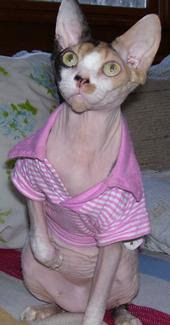
There are about 100 million pet cats in the Western world. The most popular is a combination of different breeds - the domestic shorthaired cat. The Cat Fancier's Association (CFA) holds the largest registry of pedigree cats in the world. A pedigree is the product of two parents from the same breed.
Let's take a look at the top ten most popular cat breeds of 2006, according to the CFA.
1. THE PERSIAN
Number one since the CFA first started keeping records in 1871! Although Persians are high-maintenance and need grooming every day, this is more than compensated for by their affectionate and loyal personality.
2. THE MAINE COON
This enormous all-American cat has been in second place since 1992. Maine Coons are one of the biggest domestic breeds. Males average 12 to 18 pounds in weight and females are usually 10-14. They are hardy, gentle and loving with long fur but don't need as much grooming as a Persian.
3. THE EXOTIC
These are also known as exotic shorthairs and are rounded and solid in appearance. This cat is like a Persian but with short fur. Some people call them 'a Persian in pyjamas'! They have the sweet personality of the Persian but only need combing twice a week.
4. THE SIAMESE
These cats are very communicative, yowling in a rasping voice for attention or just to chat! They are slim and athletic with large ears. Their fur is short and lies close to their skin. They love to be stroked, and are extremely loyal and close to one person. They are very intelligent and loving.
5. THE ABYSSINIAN
It is said that these pretty cats are descended from those worshipped by the ancient Egyptians - but no one knows for sure. Their coat is ticked with colors. Abyssinians are very active, busy and playful, and they love people.
6. THE RAGDOLL
Ragdolls, or 'Raggies' are extremely cute cats. They are called Ragdolls because when you pick one up, it goes completely limp in your arms! They are another large breed with males growing anything up to 20 pounds and females 15. They have blue eyes and mid-length, silky fur. They are extraordinarily affectionate and will follow you everywhere.
They are so docile that it can be dangerous for them to go out as they wouldn't defend themselves if another animal attacked them.
7. THE BIRMAN
This blue eyed cat also glories in the name of the Sacred Cat of Burma! They have characteristic white paws, making them look as if they are wearing little white boots. They have even temperaments, and are known for adjusting to your daily routine. A Birman will often be waiting for you when you get home from work (as do Siamese and Orientals). Although their fur is long and silky, they don't require much grooming.
8. THE AMERICAN SHORTHAIR
These look like regular tabbies but true American Shorthairs are pure-bred. These cats originally arrived in America on the "Mayflower" with the pilgrims. They are good hunters, have a loving nature, general good health, a quiet temperament, and they are great with children. They come in a multitude of color combinations, the most popular being silver. More than a third of all American Shorthairs have this coloring of black 'stripes' on a beautiful silver background.
9. THE ORIENTAL
This breed looks and behaves just like a Siamese but is available in two different hair lengths and over 300 different color combinations. They also have very sweet natures, and have many of the characteristics of Siamese, though they don't quite talk as loudly. But they are very affectionate and loyal, very people-oriented.
10. THE SPHYNX
This extraordinary naked cat has a rather bizarre appearance. Strangely, they are available in a multitude of colors, albeit skin colors rather than fur! They are lively and athletic, and enjoy climbing. They are loyal, loving and constantly demand attention.



















